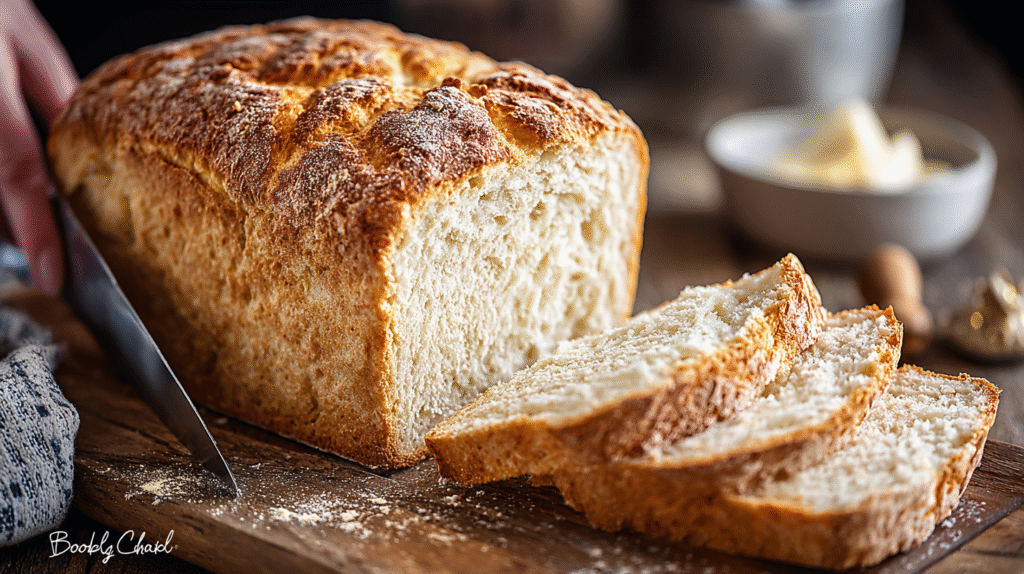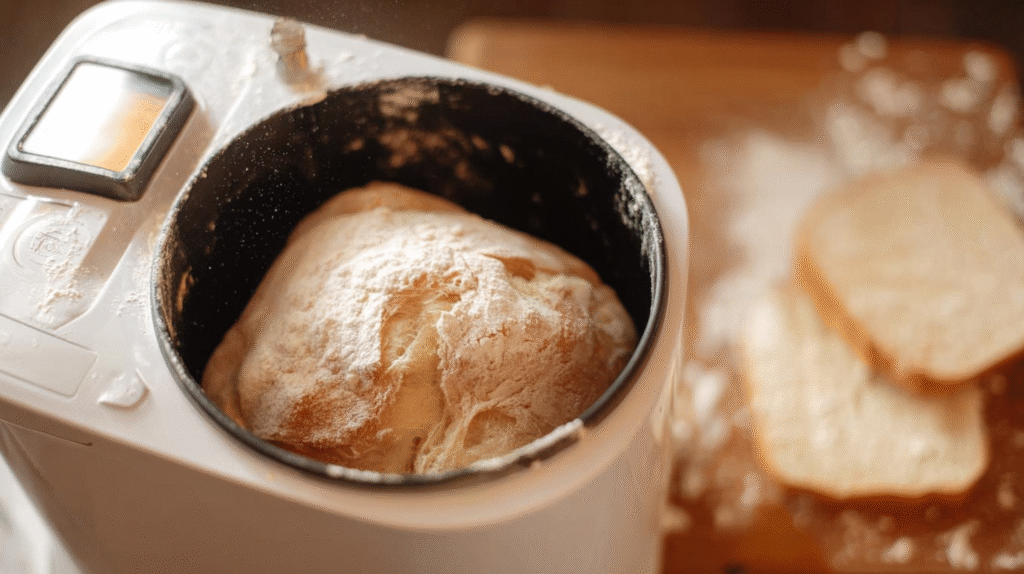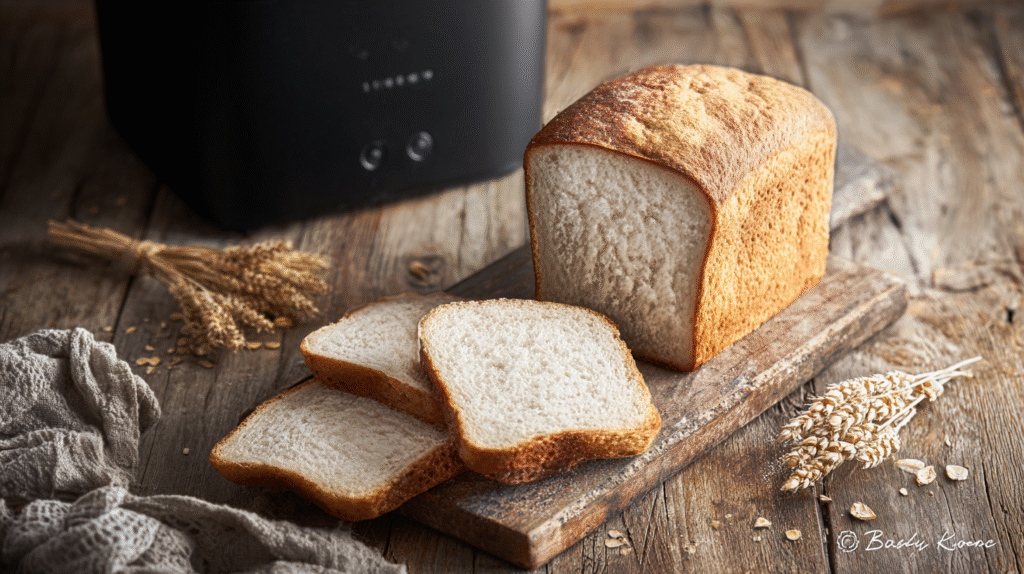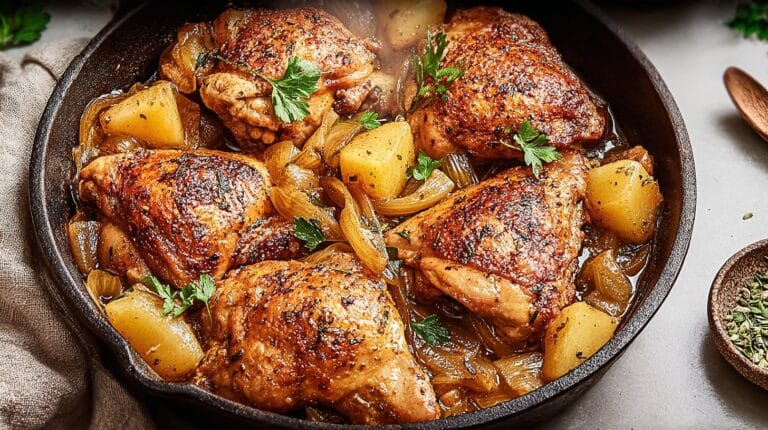Finding a reliable gluten and dairy free bread maker recipe that actually tastes good—and slices like real bread—can feel impossible. Too often, store-bought options fall apart, taste stale, or cost a fortune. This article will walk you through a foolproof gluten and dairy free bread maker recipe that’s soft, flavorful, and surprisingly affordable. We’ve tested different gluten-free flours, perfected the ratios, and included tips for any bread machine—even ones without a gluten-free setting. Whether you’re new to gluten-free baking or tired of failed loaves, this guide gives you everything you need to bake success.

The Ultimate Gluten-Free Dairy-Free Bread Maker Recipe (Vegan & Egg-Free)
- Total Time: 2 hours 10 minutes
- Yield: 1 loaf (14 slices) 1x
Description
Soft, sliceable, and vegan—this gluten and dairy free bread maker recipe makes the best homemade loaf using easy-to-find ingredients.
Ingredients
1½ cups warm almond milk or oat milk
¼ cup olive oil or vegan butter
6 tbsp aquafaba (liquid from canned chickpeas)
1 tbsp apple cider vinegar
3 tbsp maple syrup or honey
3 cups King Arthur Gluten-Free All-Purpose Flour
1 tsp salt
1½ tsp psyllium husk powder
1 tbsp sugar (optional, for crust)
2 tsp instant yeast
Instructions
1. Add all wet ingredients to your bread pan in the listed order.
2. Gently add all dry ingredients on top of the wet layer.
3. Make a small well in the center of the flour and pour in yeast.
4. Select the gluten-free setting. If not available, use Quick/Rapid cycle with one rise.
5. Optionally remove paddle after final knead cycle to reduce bottom holes.
6. Let loaf cool for 10 minutes in pan, then transfer to wire rack.
7. Allow to cool completely (2–3 hours) before slicing.
8. Store in airtight container at room temp for 24 hours, then refrigerate.
Notes
* For egg version: replace aquafaba with 2 large eggs.
* Flour swap: Pillsbury GF flour works well if King Arthur is unavailable.
* To freeze: Slice, separate with parchment, freeze in airtight bag.
* For a crisp crust, toast before serving.
- Prep Time: 10 minutes
- Cook Time: 2 hours
- Category: Bread
- Method: Bread Machine
- Cuisine: Gluten-Free
Nutrition
- Serving Size: 1 slice
- Calories: 155
- Sugar: 3g
- Sodium: 180mg
- Fat: 5g
- Saturated Fat: 1g
- Unsaturated Fat: 3g
- Trans Fat: 0g
- Carbohydrates: 25g
- Fiber: 3g
- Protein: 2g
- Cholesterol: 0mg
Keywords: gluten and dairy free bread maker recipe, vegan bread machine loaf, egg-free gluten free bread
Why Store-Bought Bread Failed Me (And How This Recipe Solves It)
A Mom’s Journey to Better Bread
Years ago, I stood in a grocery aisle holding yet another disappointing $7 loaf of gluten-free bread—tiny, stiff, and full of mystery ingredients. After my family transitioned to a gluten and dairy free lifestyle, the struggle for decent bread became painfully real. And I’m not alone.
On Recent Recipe, we believe food should feel like home. That means bringing back soft sandwiches, warm toast, and bread that doesn’t taste like cardboard. This recipe started in my kitchen, driven by the same frustration—and inspired by my love for hearty meals like dinner soups that need the perfect slice on the side.
One Recipe to Rule Them All
This is more than just a gluten and dairy free bread maker recipe—it’s a tried-and-true solution. It’s completely vegan (no eggs), nut-optional, and it uses easy-to-find ingredients. You won’t need weird specialty flours or expensive brands that only work in one situation. We tested common flours like King Arthur and Pillsbury so you don’t have to.
What makes it different?
- The dough is wet like batter, not stiff like regular bread dough. That’s not a mistake—it’s the secret.
- It uses aquafaba (the liquid from canned chickpeas) instead of eggs, giving lift and structure.
- It only needs one rise cycle, perfect for any bread machine—even those without a gluten-free setting.
You’ll get a loaf with a soft interior, a golden crust, and slices that hold up for sandwiches or avocado toast. And best of all? Your kitchen will smell like fresh-baked bread—not defeat.
Next, let’s dive into the complete ingredient list and how to prep it step-by-step, whether your machine has a gluten-free setting or not.
Foolproof Gluten and Dairy Free Bread Machine Recipe
Ingredients You Can Trust (With Substitutions)
Creating a dependable gluten and dairy free bread maker recipe starts with selecting the right ingredients. Here’s everything you need for a 2 lb loaf that’s soft, flavorful, and 100% vegan.
| Ingredient | Role |
|---|---|
| 1½ cups warm unsweetened almond milk | Moisture, helps dissolve yeast |
| ¼ cup olive oil or melted vegan butter | Fat, creates soft crumb |
| 6 tbsp aquafaba (liquid from canned chickpeas) | Egg substitute, adds structure |
| 1 tbsp apple cider vinegar | Boosts rise and balances flavor |
| 3 tbsp maple syrup or honey | Feeds yeast, subtle sweetness |
| 3 cups King Arthur Gluten-Free All-Purpose Flour | Main structure – best for yeast-based baking |
| 1 tsp salt | Flavor enhancer |
| 1½ tsp psyllium husk powder | Gluten replacement – improves structure |
| 1 tbsp sugar (optional) | Enhances crust color and flavor |
| 2 tsp instant or rapid-rise yeast | Leavening |
Substitutions:
- No aquafaba? Use 2 tbsp flaxseed + 5 tbsp water, sit 10 min.
- No almond milk? Use oat, rice, or soy milk.
- Not vegan? Replace aquafaba with 2 large room-temp eggs.
Step-by-Step Instructions for Any Bread Machine
This recipe is designed to work whether your bread machine has a “gluten-free” setting or not. Here’s how to get it right every time.
Step 1: Add Wet Ingredients to Bread Pan
Start by warming your plant milk slightly (not hot). Add it to the bread pan, followed by oil, aquafaba, apple cider vinegar, and maple syrup.
Step 2: Add Dry Ingredients on Top
Gently layer your flour on top of the wet ingredients. Sprinkle in salt, psyllium husk, and sugar (if using). Do not stir.
Step 3: Make a Yeast Well
Gently create a small well in the center of the flour using your finger or a spoon. Pour yeast into the hole. This keeps it from activating too soon.
Step 4: Set Your Bread Machine
- If you have a gluten-free setting: Select it and start.
- If you don’t: Use a “Quick,” “Rapid,” or “Basic” setting that has only one rise. Gluten-free dough does not need a second rise and will collapse if over-proofed.
Optional Tip: After the final knead cycle (your machine may beep), quickly remove the paddle with a spatula to avoid big holes in your loaf.

Step 5: Let It Cool
Once baking is complete, remove the pan and let the bread sit for 10 minutes. Then transfer to a cooling rack and let it cool completely (2–3 hours) before slicing.
Texture Tip: The dough will look like thick cake batter during mixing—this is normal for gluten-free recipes.
Secrets Behind the Texture (And What NOT to Do)
Why Typical Flours Fail (And Ours Doesn’t)
The number one reason gluten-free bread fails? Using the wrong flour. Not all gluten-free flour blends are created equal—some are made for cookies, not yeast breads.
Let’s break it down:
Avoid “Measure-for-Measure” or “1-to-1” Blends for Yeast Bread
Popular blends like Bob’s Red Mill 1-to-1 or King Arthur Measure for Measure state on their packaging: “Not recommended for yeast baking.” Why? Because they’re formulated to mimic all-purpose flour in quick-bake recipes (like desserts), not for yeast development.
These blends may cause:
- A dense, wet loaf that doesn’t rise
- Over-proofing or collapse after baking
- Gummy centers, even after full bake time
Use King Arthur Gluten-Free All-Purpose Flour Instead
This flour is specifically made without added gums, making it ideal for recipes where you control the binder, like this one. It bakes up evenly with a soft texture that slices cleanly.
Supermarket Alternative: Pillsbury Gluten-Free Flour
Can’t find King Arthur? Pillsbury’s gluten-free blend performs well in bread machines too and is widely available. Just ensure it doesn’t contain added xanthan gum if you’re also using psyllium husk.
Gluten-Free Bread Machine Success Starts with Science
Getting good gluten-free bread comes down to understanding a few simple principles:
1. One Rise Only
Unlike traditional doughs, gluten-free mixtures don’t benefit from multiple rises. They lack gluten’s elasticity to hold structure, so a second rise actually weakens the loaf. That’s why this gluten and dairy free bread maker recipe uses only one cycle.
2. Wet Dough Is Right
Don’t panic when your dough looks like thick pancake batter. This moisture allows the starches and binders to activate properly during baking, giving you an airy, tender interior.
3. Psyllium Husk vs. Xanthan Gum
Psyllium husk powder is our go-to for this recipe. It mimics gluten’s stretch and improves moisture retention. If using xanthan gum, reduce to 1 tsp per cup of flour—more can make the texture rubbery.
4. Aquafaba Works Better Than Flax in Bread Machines
Flax eggs work well for cookies or pancakes, but in yeast bread, aquafaba produces a lighter crumb and cleaner flavor. It emulsifies like egg whites, giving lift without overpowering the dough.
Cost Breakdown: Homemade vs. Store-Bought
You don’t just save money with this recipe—you get more bread and better flavor. Here’s how it stacks up:
| Brand | Approx. Cost | Slices |
|---|---|---|
| Homemade (this recipe) | $3.25 | 14–16 |
| Udi’s Gluten Free Bread | $6.49 | 12 (small) |
| Canyon Bakehouse | $7.29 | 14 |
That’s over 50% savings—plus, no plastic packaging, no preservatives, and better flavor.
Slicing, Storing, and Serving Tips
Wait to Slice
Allow the loaf to cool completely on a wire rack for 2 to 3 hours. Cutting early releases steam and leads to a gummy texture.
How to Store It
Once cool, wrap in parchment and place in an airtight container. Store at room temperature for one day, or refrigerate for up to five.
Freezer-Friendly? Yes.
Slice the loaf, freeze individual slices between parchment, and toast directly from frozen.
Best Ways to Serve
- Toasted with jam for breakfast
- Grilled with lunch fillings like avocado or hummus
- Alongside soups or stews
- As sandwich bread with vegan mayo and crisp veggies

Table of contents
Table of Contents
Can I use flaxseed instead of aquafaba?
Yes, you can. For every 3 tbsp of aquafaba, mix 1 tbsp of ground flaxseed with 2.5 tbsp of water. Let it sit for 10 minutes before using. However, aquafaba gives a lighter, more airy crumb in this gluten and dairy free bread maker recipe.
Can I make this nut-free?
Absolutely. Swap almond milk for oat, rice, or soy milk. Just avoid coconut milk if you prefer a milder flavor.
Do I need a bread machine with a gluten-free setting?
No. While it helps, it’s not required. Choose the “Quick” or “Basic” setting—anything with only one rise cycle. This avoids over-proofing, which collapses gluten-free doughs.
Can I make this with sourdough starter?
No, this recipe is specifically designed for instant or rapid-rise yeast. Sourdough uses a different hydration level and proofing process that doesn’t work well in bread machines.
Can I bake this without a bread machine?
Yes, just mix the ingredients, let the dough rise once in a warm area, then bake it in a greased loaf pan at 375°F for 45–55 minutes. But the bread machine simplifies the timing perfectly.







